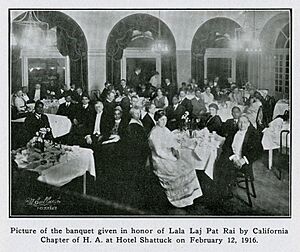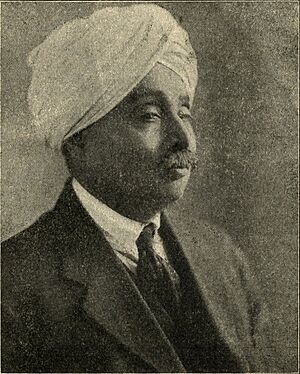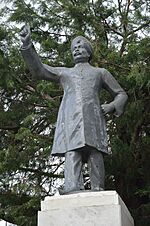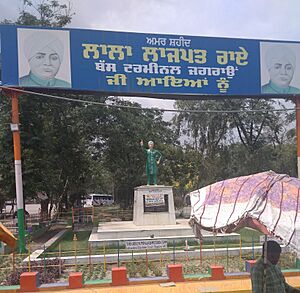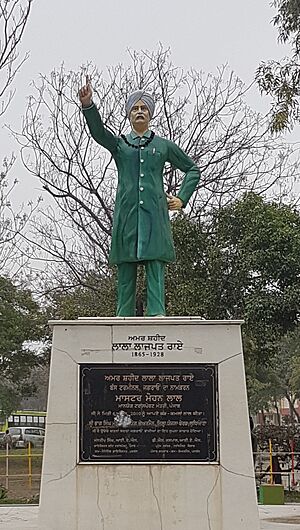Lala Lajpat Rai facts for kids
Quick facts for kids
Lala Lajpat Rai
|
|
|---|---|
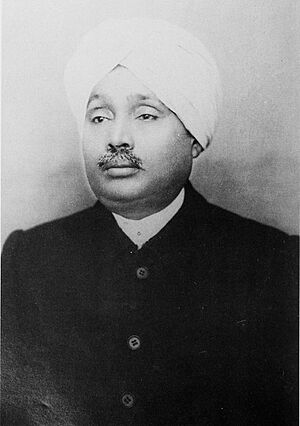
Rai in 1924
|
|
| Born | 28 January 1865 |
| Died | 17 November 1928 (aged 63) |
| Cause of death | Injuries sustained during a lathi charge |
| Nationality | Indian |
| Other names | Punjab Kesari |
| Occupation | |
| Political party | Indian National Congress |
| Movement | India's independence |
| Spouse(s) | Radha Devi Aggarwal |
Lala Lajpat Rai (born January 28, 1865 – died November 17, 1928) was a brave Indian leader. People knew him as Punjab Kesari, which means 'Lion of Punjab'. He was a key figure in India's fight for freedom from British rule.
Lala Lajpat Rai was part of a famous trio of leaders called Lal Bal Pal. He worked as a lawyer, writer, and politician. He sadly died from injuries he got during a peaceful protest. He was leading a march against the British government's new rules.
Contents
Early Life and Education
Lala Lajpat Rai was born in a village called Dhudike in Punjab, India. This was on January 28, 1865. He was the oldest of six children. His father, Munshi Radha Krishna, was a school teacher.
He spent many of his younger years in Jagraon. His childhood home there is now a library and museum. He also helped build a school in Jagraon.
Learning to Lead
Lajpat Rai started his education in Rewari. Later, in 1880, he went to Government College in Lahore to study law. There, he met other future freedom fighters.
He was inspired by Swami Dayanand Saraswati. This leader started a Hindu reform movement called Arya Samaj. Lajpat Rai joined this group and helped spread its ideas. He also started a newspaper called Arya Gazette.
A Career for India's Freedom
Becoming a Lawyer
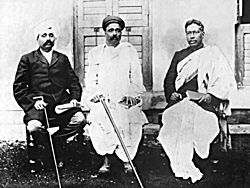
After finishing his studies, Lajpat Rai began practicing law. He worked in Hisar and later moved to Lahore. He became a well-known lawyer.
He also helped start important organizations. In 1886, he helped create the Dayananda Anglo-Vedic School in Lahore. He also set up branches of the Indian National Congress and the Arya Samaj in Hisar. These groups were important for India's future.
Lajpat Rai also wrote for newspapers like The Tribune. He wanted to share his ideas about India's freedom. In 1914, he stopped practicing law. He wanted to focus all his energy on the independence movement.
Joining the Fight for Independence
Lala Lajpat Rai joined the Indian National Congress. This was a major political party fighting for India's freedom. Because of his strong views, the British sent him away to Mandalay for a short time.
He helped start the National College in Lahore. This school offered an education different from the British style. Famous freedom fighters like Bhagat Singh studied there. In 1920, he became the President of the Indian National Congress.
In 1921, he started the Servants of the People Society. This group helped people in need. He believed that Indian society needed to improve. He wanted to fight against the caste system and improve the lives of women.
Travels for Freedom
Lajpat Rai traveled to the United States during World War I. He visited different communities and met with many people. He wrote a book about his travels called The United States of America (1916).
While in the U.S., he started the Indian Home Rule League of America. This group worked to gain support for India's independence. He also published a magazine called Young India. He asked the U.S. government to support India's freedom.
He returned to India in 1919. The next year, he helped start the non-co-operation movement. This was a big protest against British rule. He was put in jail from 1921 to 1923 for his actions.
Protesting the Simon Commission
In 1928, the British government sent a group called the Simon Commission to India. This group was supposed to suggest changes to India's government. But there were no Indian members in the commission. This made Indians very angry.
Lajpat Rai led a big, peaceful protest in Lahore on October 30, 1928. The protesters chanted "Simon Go Back!" and carried black flags. The police chief, James A. Scott, ordered his officers to use their sticks, called lathis, on the crowd.
Lajpat Rai was badly hurt during this attack. Even though he was injured, he spoke to the crowd. He famously said, "I declare that the blows struck at me today will be the last nails in the coffin of British rule in India."
His Final Days
Lala Lajpat Rai never fully recovered from his injuries. He passed away on November 17, 1928. Many believed the police attack caused his death. His sacrifice became a symbol of British cruelty. It made many more Indians join the fight for freedom.
Lala Lajpat Rai's Lasting Impact
Lala Lajpat Rai was a very important leader. He inspired many young people to join the independence movement. Leaders like Chandrasekhar Azad and Bhagat Singh looked up to him.
Organizations and Institutions He Started
Lajpat Rai started many important groups. These included the Hisar Congress and the Hisar Bar Council. He also led the national DAV Managing Committee. He was involved with the Lakshmi Insurance Company.
In 1927, he set up a trust to build a hospital for women. This hospital was named Gulab Devi Chest Hospital, after his mother. It opened in 1934 and is now a very large hospital in Pakistan.
In 1926, he created the R.K. Trust to honor his father. This trust later established the Lala Lajpat Rai Memorial College in Jagraon. This college is now known as Lajpat Rai DAV College.
Places Named After Him
Many places in India are named after Lala Lajpat Rai. There is a statue of him in Shimla. In Mumbai, the Lala Lajpat Rai College of Commerce and Economics is named after him.
Other places include the Lala Lajpat Rai Memorial Medical College in Meerut. The Lala Lajpat Rai Institute of Engineering and Technology, Moga and the Lala Lajpat Rai University of Veterinary & Animal Sciences in Hisar also bear his name.
In Delhi, you can find Lajpat Nagar and Lajpat Rai Market. There are also many roads, schools, and libraries named after him across India. His hometown of Jagraon has a bus terminal and other institutes named in his honor.
His Writings
Lala Lajpat Rai was a talented writer. Besides editing Arya Gazette, he wrote for many newspapers and magazines. He also wrote several books, sharing his thoughts on India's future.
Some of his famous books include:
- The Story of My Deportation (1908)
- Arya Samaj (1915)
- The United States of America: A Hindu’s Impression (1916)
- Unhappy India (1928)
- Young India: An Interpretation and a History of the Nationalist Movement from Within. (1916)
He also wrote biographies of famous people like Mazzini, Garibaldi, Shivaji, and Shri Krishna. His writings helped inspire many people to join the freedom struggle.
Images for kids


